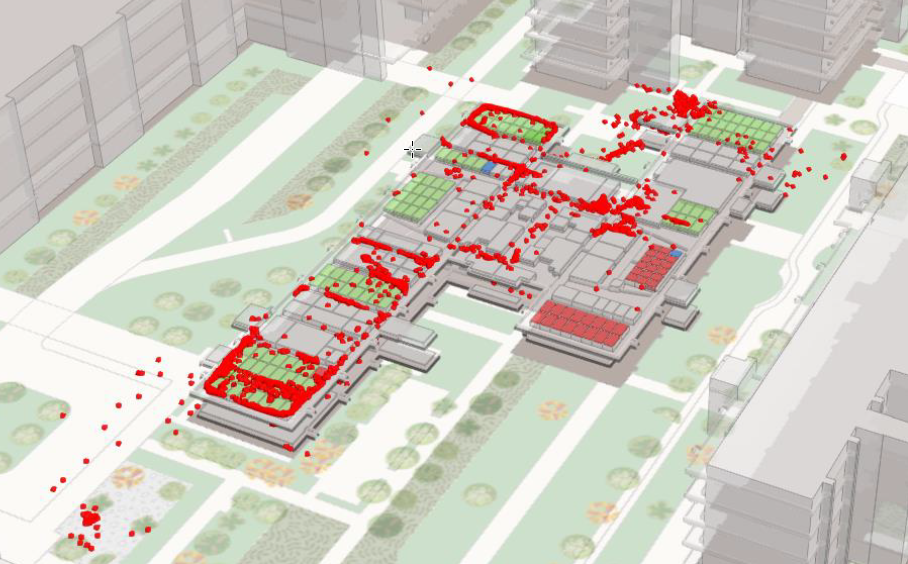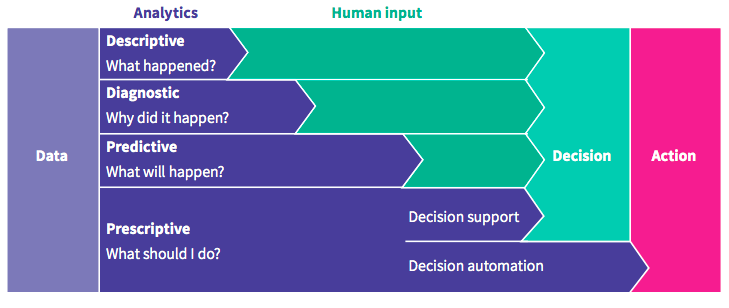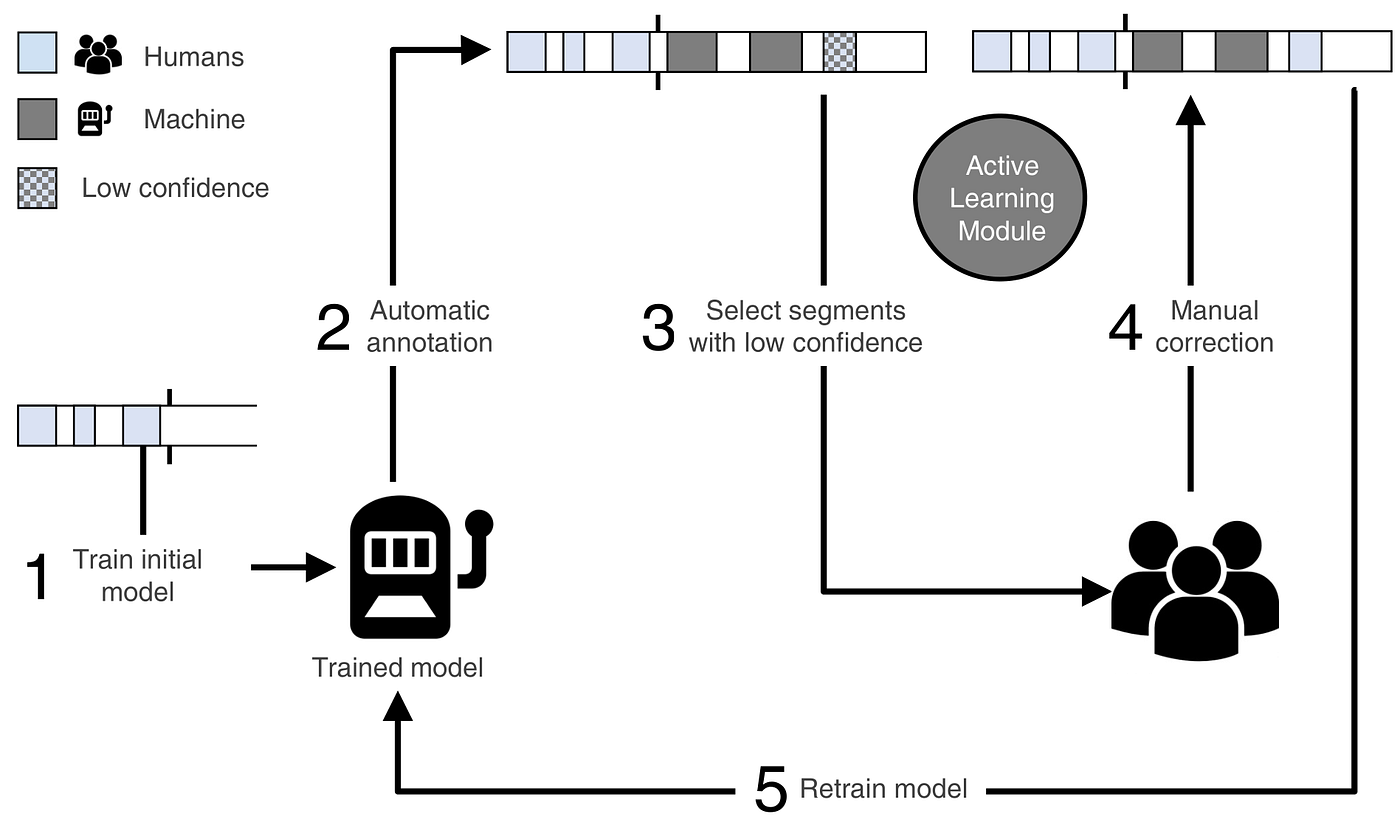
This is still a very early stage of POC. With a pre-defined datasets, with many WIFI APP signal strengths data try to prdict the real location of the indoor room.
This might be the first POC try to define our input and output data formats.
Also, this POC also be a high level connector of several different components together since it will leaverage multi factor information to conclude a precise indoor locationing.


When it comes to localization within buildings, a distinction can be made between client-based (Active tracking) and server-based positioning ( Passive tracking + Active tracking as optional). Client-based localization enables determining the position directly on the end user's device (e. g. smartphone). In the case of server-based localization, positioning takes place on a server.

Client-Based Indoor Positioning Compared: Wi-Fi vs. BLE vs. UWB vs. RFID vs. Ultrasound

| Technology |
Accuracy |
Range |
| WIFI |
<15m |
<150m |
| BLE 4 |
<8m |
<75m |
| BLE 5.1 |
<1m |
<75m |
| UWB |
<30cm |
<150m |
| RFID |
Present detection only |
<1m |
Server-Based Indoor Positioning Compared: Wi-Fi vs. BLE vs. UWB vs. RFID vs. Ultrasound

| Technology |
Accuracy |
Range |
| WIFI |
<15m |
<150m |
| BLE 4 |
<8m |
<75m |
| BLE 5.1 |
<1m |
<75m |
| UWB |
<30cm |
<150m |
| RFID |
Present detection only |
<1m |
| Ultrasound |
<4m |
<8m or Wall |
| Indoor Positioning Technology |
Comments |
| Client-Based |
No server setup. Use existing framework. but, low precision |
| Server-Based (Passive tracking only) |
Server only. 3-5 sec delay. Not realtime application |
| Server-Based (Passive+Active tracking) |
Need sever+client to get hybrid info for realtime & stable location info |

Many different use cases.
Get info of device='dlc2.barco.com' & family='barco' from find3 server
| curl -s -L -XGET "http://dlc1.barco.com:8005/api/v1/location_basic/barco/dlc2.barco.com"
|
Get WIFI/BT SSID, BSSID, RSSID of the location and device
| curl -XGET http://dlc1.barco.com:8005/api/v1/location/barco/dlc2.barco.com
|
Get all devices within 1 minsfrom family='barco' from find3 server and output it as a table
| curl -s -L -XGET "http://dlc1.barco.com:8005/api/v1/by_location/barco?history=1&num_scanners=1" | jq -s '.[] | .locations | .[] |.devices' | jsoncsv -A | mkexcel | csvcut -d , -C 5 |csvlook --snifflimit 0 | sudo tee output.txt
|
Update GPS info of location 'Aris Cube' (device=dlc2.barco.com)
| curl -s -L -XPOST "http://dlc1.barco.com:8005/api/v1/gps" -H "Content-Type:application/json" --data-binary '{"f":"Barco","l":"Aris Cube","gps":{"lat":25.01290,"lon":121.46701,"alt":0}}'
|
Delete family=barco data (Dangersous operation!!! Warning!!!)
| curl -s -L -XDELETE "http://dlc1.barco.com:8005/api/v1/database/barco"
|

| Signal strength (dBm) |
Expected Quality |
| -90 |
Chances of connecting are very low at this level |
| -80 |
Unreliable signal strength |
| -67 |
Reliable signal strength– the edge of what Cisco considers to be adequate to support Voice over WLAN |
| -55 |
Anything down to this level can be considered excellent signal strength. |
| -30 |
Maximum signal strength, you are probably standing right next to the access point. |
| Rssi |
Freq |
Type |
Algo |
Rate |
BSSID |
SSID |
| -50 |
2.412 GHz |
802.11n |
6 |
12 |
E8 D0 FC BF 18 0D |
ClickShare-Mobile-CX20 |
| -52 |
5.825 GHz |
802.11ac |
7 |
8 |
04 D4 C4 D3 42 84 |
ASUS_Automation_5G |
| -72 |
5.825 GHz |
802.11ac |
7 |
8 |
E4 AA EA 58 43 93 |
CX-50-DEMO-RICHEN |
| -50 |
2.457 GHz |
802.11n |
7 |
12 |
B0 7F B9 82 03 04 |
NETGEAR25 |
| -66 |
2.437 GHz |
|
7 |
7 |
F0 1D 2D 5D A9 C0 |
Barco |
| -58 |
5.24 GHz |
802.11n |
6 |
8 |
28 24 FF 69 5B B7 |
TestRoom_CSE800_mac (5GHz) |
| -55 |
2.437 GHz |
|
7 |
7 |
F0 1D 2D 5B 54 61 |
Barco Guest |
| -61 |
5.24 GHz |
802.11ac |
1 |
8 |
3C 91 80 84 95 07 |
ClickShare-HW-UniSee |
| -71 |
5.24 GHz |
802.11ac |
7 |
8 |
E4 AA EA 35 04 65 |
ClickShare-1863551994 |
| -55 |
2.437 GHz |
802.11n |
7 |
12 |
BE 42 4F CB C3 44 |
TestRoom-EAP-WinServer |
| -46 |
5.785 GHz |
|
6 |
8 |
7C 10 C9 61 97 84 |
TAI-QA-ASUSROG-6E_5G |
| -49 |
5.18 GHz |
802.11ac |
7 |
8 |
10 63 C8 97 03 9F |
TAI_MR08 |
| -58 |
5.785 GHz |
802.11ac |
7 |
8 |
BC CF 4F CB C3 43 |
TestRoom-EAP |
| -63 |
5.18 GHz |
802.11ac |
6 |
8 |
3C 91 80 84 9C 5D |
ClickShare-1862300001 |
| -59 |
5.3 GHz |
|
7 |
6 |
F0 1D 2D 5A D5 6F |
Barco |
| -57 |
2.412 GHz |
802.11n |
7 |
12 |
D4 6E 0E 41 61 EA |
keroro24 |
| -60 |
5.32 GHz |
|
9 |
6 |
F0 1D 2D 5B 54 6E |
Barco Guest |
| -68 |
5.58 GHz |
|
7 |
6 |
F0 1D 2D 5A D9 8D |
BarcoIoT |
| -55 |
5.18 GHz |
802.11ac |
7 |
8 |
3C 91 80 84 9C 5F |
TAI_MR09 |
| -59 |
5.745 GHz |
802.11ac |
7 |
8 |
E4 AA EA 74 46 FF |
ClickShare-Mobile-CX50 |
| -53 |
2.412 GHz |
|
7 |
7 |
F0 1D 2D 5A D5 62 |
BarcoIoT |
| -69 |
5.805 GHz |
802.11ac |
6 |
8 |
D4 6E 0E 41 61 E9 |
keroro5 |
| -62 |
5.24 GHz |
802.11ac |
7 |
8 |
F8 A2 D6 6E 09 CF |
TestRoom_CSE200P_mac |
| -58 |
5.785 GHz |
802.11ac |
7 |
8 |
BE 43 4F CB C3 45 |
TestRoom-EAP-WinServer |
| -73 |
5.68 GHz |
|
7 |
6 |
F0 1D 2D 5C 27 CF |
|
| -39 |
2.447 GHz |
802.11n |
7 |
12 |
2C FD A1 CD 32 38 |
ASUS |
| -69 |
5.765 GHz |
802.11ac |
7 |
8 |
70 2E D9 42 F4 76 |
MAXHUB-6BF |
| -56 |
5.745 GHz |
802.11ac |
7 |
8 |
E4 AA EA 35 21 3F |
SClickShare-1863551600 |
| -58 |
5.785 GHz |
802.11ac |
7 |
8 |
BE 43 4F CB C3 44 |
TestRoom-PSK2 |
| -62 |
2.412 GHz |
802.11n |
7 |
12 |
E8 D0 FC BF 13 5F |
ClickShare-1862300251 |
| -59 |
5.18 GHz |
802.11ac |
7 |
8 |
E4 AA EA 74 2C D3 |
ClickShare-1863553421 |
| -60 |
2.452 GHz |
802.11n |
7 |
12 |
04 D4 C4 35 69 E8 |
ASUS_SQA_JessicaHsu_2.4G |
| -59 |
5.18 GHz |
802.11ac |
7 |
8 |
3C 91 80 84 95 D3 |
ClickShare-MR12 |
| -69 |
2.412 GHz |
|
1 |
7 |
F0 1D 2D 5A D9 82 |
BarcoIoT |
| -61 |
2.412 GHz |
802.11n |
7 |
12 |
BC 30 7E F1 1D 9B |
ClickShare Audi-1 |
| -61 |
5.18 GHz |
802.11ac |
7 |
8 |
3C 91 80 84 97 59 |
ClickShare-1862300078 |
| -60 |
5.32 GHz |
|
7 |
6 |
F0 1D 2D 5B 54 6F |
|
| -78 |
2.437 GHz |
802.11n |
7 |
8 |
02 21 6A F8 2F AF |
DIRECT-ZWTAICLT24036msZe |
| -62 |
5.24 GHz |
802.11ac |
1 |
8 |
02 12 5F 17 67 2F |
WiCS-2100-72E |
| -59 |
2.462 GHz |
802.11n |
7 |
12 |
00 D0 41 DC 13 C8 |
myvita |
| -55 |
5.18 GHz |
802.11ac |
7 |
8 |
3C 91 80 84 9F 25 |
ClickShare-0716174986 |
| -71 |
5.18 GHz |
802.11ac |
7 |
8 |
10 63 C8 A7 9E 23 |
TAI_MR04 |
| -86 |
5.18 GHz |
802.11ac |
1 |
8 |
10 63 C8 96 FF 87 |
TAI_MR01 |
| -28 |
2.427 GHz |
802.11n |
1 |
12 |
7A DA 88 B2 74 EC |
|
| -66 |
2.422 GHz |
802.11n |
7 |
12 |
BC 30 7E DD 3D FE |
WiPG-1000-78C |
| -56 |
5.18 GHz |
802.11ac |
7 |
8 |
F8 A2 D6 8D BF 8F |
ClickShare-1863550102 |
| -59 |
5.3 GHz |
|
7 |
6 |
F0 1D 2D 5A D5 6D |
BarcoIoT |
| -73 |
5.24 GHz |
802.11n |
7 |
8 |
D8 61 62 8B 1D EF |
TAI-MR06-Pingtung |
| -52 |
5.18 GHz |
802.11ac |
7 |
8 |
12 63 C8 14 92 3B |
DIRECT-BM |
| -83 |
5.68 GHz |
|
7 |
6 |
F0 1D 2D 5A CC AE |
Barco Guest |
| -81 |
5.26 GHz |
|
7 |
6 |
F0 1D 2D 5D B2 AF |
|
| -68 |
2.437 GHz |
802.11n |
7 |
12 |
BC EE 7B 7D 46 C0 |
|
| -81 |
5.745 GHz |
802.11ac |
7 |
8 |
02 12 5F 17 68 8C |
WiCS-2100-88B |
| -68 |
5.58 GHz |
|
7 |
6 |
F0 1D 2D 5A D9 8E |
Barco Guest |
| -55 |
2.437 GHz |
802.11n |
1 |
12 |
BE 42 4F CB C3 43 |
TestRoom-PSK2 |
| -77 |
5.745 GHz |
802.11ac |
7 |
8 |
02 12 5F 17 66 66 |
WiCS-2100-665 |
| -52 |
5.18 GHz |
802.11n |
7 |
8 |
28 24 FF 4D 1B FD |
ClickShare-1872075087 |
| -82 |
5.2 GHz |
802.11n |
1 |
8 |
BC 30 7E D9 C3 F4 |
ClickShare-8000000049 |
| -72 |
5.18 GHz |
802.11ac |
7 |
8 |
E4 AA EA 74 26 59 |
CX-50_Service |
| -71 |
5.18 GHz |
802.11ac |
7 |
8 |
E8 D0 FC BF 15 D1 |
Agile 01 |
| -58 |
5.18 GHz |
802.11ac |
7 |
8 |
3C 91 80 84 95 B3 |
ClickShare-1862300131 |
| -48 |
5.745 GHz |
802.11ac |
7 |
8 |
2C FD A1 CD 32 3C |
ASUS_5G |
| -47 |
5.18 GHz |
802.11ac |
6 |
8 |
E4 AA EA 58 45 8B |
ClickShare-1863552495 |
| -84 |
5.22 GHz |
802.11ac |
7 |
8 |
3C 91 80 84 98 13 |
TAI_MR03 |
| -69 |
5.18 GHz |
802.11n |
7 |
8 |
B8 B7 F1 01 B0 2D |
ClickShare-1873124000 |
| -45 |
2.412 GHz |
802.11n |
1 |
12 |
C8 60 00 AC FB 30 |
ASUS-FA |
| -64 |
2.462 GHz |
|
1 |
7 |
F0 1D 2D 5C 27 C0 |
|
| -68 |
5.58 GHz |
|
7 |
6 |
F0 1D 2D 5A D9 8F |
Barco |
| -54 |
2.412 GHz |
|
7 |
7 |
F0 1D 2D 5A D5 61 |
Barco Guest |
| -64 |
5.745 GHz |
802.11ac |
7 |
8 |
02 12 5F 17 67 F2 |
WiCS-2100-LIN |
| -53 |
5.2 GHz |
802.11ac |
9 |
8 |
04 D4 C4 35 69 EC |
ASUS_SQA_JessicaHsu_5G |
| -64 |
2.462 GHz |
|
7 |
7 |
F0 1D 2D 5C 27 C2 |
BarcoIoT |
| -59 |
5.18 GHz |
802.11ac |
7 |
8 |
F8 A2 D6 8D BF 5D |
ClickShare-1863550098 |
| -81 |
5.745 GHz |
802.11ac |
7 |
8 |
02 12 5F 30 00 AC |
WiCS-2100-0AB |
| -53 |
2.462 GHz |
802.11n |
7 |
12 |
00 4E 35 1A C8 60 |
TAI-ClickShare-WPA2-DFS |
| -73 |
5.68 GHz |
|
9 |
6 |
F0 1D 2D 5C 27 CD |
BarcoIoT |
| -59 |
5.18 GHz |
802.11ac |
7 |
8 |
F8 A2 D6 8D CB 39 |
ClickShare-1863550140 |
| -75 |
5.22 GHz |
802.11n |
7 |
8 |
28 24 FF 5B 05 05 |
CSE-200-demo |
| -61 |
5.18 GHz |
802.11ac |
7 |
8 |
10 63 C8 BF B1 81 |
ClickShare-1862337967 |
| -80 |
5.26 GHz |
|
7 |
6 |
F0 1D 2D 5D B2 AE |
Barco Guest |
| -53 |
5.18 GHz |
802.11ac |
1 |
8 |
A0 40 A0 82 49 0E |
QA-test-5G |
| -51 |
2.412 GHz |
802.11n |
7 |
12 |
10 63 C8 96 F7 F3 |
ClickShare-T20 |
| -60 |
5.32 GHz |
|
7 |
6 |
F0 1D 2D 5B 54 6D |
BarcoIoT |
| -43 |
5.22 GHz |
|
7 |
8 |
6C CD D6 F5 9D 69 |
HW_WIFI6E_5G |
| -52 |
2.462 GHz |
802.11n |
7 |
12 |
18 31 BF C5 D1 38 |
SQA_Balloon_24G |
| -82 |
5.68 GHz |
|
7 |
6 |
F0 1D 2D 5A CC AF |
Barco |
| -84 |
5.745 GHz |
802.11ac |
7 |
8 |
02 12 5F 30 06 4F |
WiCS-2100-64E |
| -45 |
2.437 GHz |
|
7 |
12 |
7C 10 C9 61 97 80 |
TAI-QA-ASUSROG-6E_2.4G |
| -58 |
5.18 GHz |
802.11ac |
7 |
8 |
E4 AA EA 58 43 81 |
ClickShare-1863552454 |
| -75 |
5.5 GHz |
|
7 |
6 |
F0 1D 2D 5D A9 CD |
BarcoIoT |
| -75 |
5.18 GHz |
802.11ac |
7 |
8 |
D8 F3 BC 54 4B 89 |
ClickShare-1862375851 |
| -43 |
2.472 GHz |
|
7 |
12 |
08 36 C9 2F 78 F5 |
TAI-QA-NetGear-2.4G |
| -63 |
2.412 GHz |
802.11n |
7 |
12 |
3C 91 80 84 9C 91 |
ClickShare-1862300102 |
| -68 |
2.412 GHz |
|
6 |
7 |
F0 1D 2D 5A D9 80 |
Barco |
| -66 |
2.437 GHz |
|
7 |
7 |
F0 1D 2D 5D A9 C2 |
BarcoIoT |
| -63 |
5.5 GHz |
802.11ac |
7 |
8 |
00 4E 35 1A C8 70 |
TAI-ClickShare-WPA2-DFS |

Can't see the following page? Please login to MS office first.






































